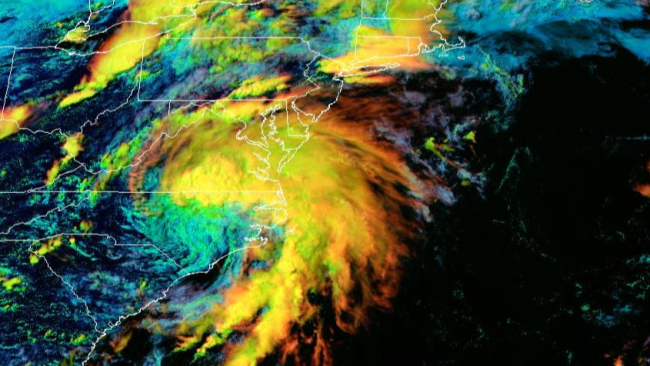6 things to know about Tropical Storm Elsa

 |
A satellite image showing Tropical Storm Elsa tracking northward along the Eastern Seaboard of the U.S. on Thursday, July, 8, 2021. (NOAA / GOES East) |
Elsa's journey northward was loaded with curveballs. The storm system teetered between its official hurricane or tropical storm status, doling out tornado warnings, power outages and significant flooding along the way.
On Friday, the storm made its way up the East Coast through the mid-Atlantic and into New England before it was forecast to take aim at Atlantic Canada. Here are six things to know about Elsa, which AccuWeather meteorologists began alerting the public about the potential for on June 29:
With its formation during the evening hours on June 30, Eastern Daylight Time, Elsa dethroned Tropical Storm Edouard as the earliest E-named storm on record in the Atlantic basin. Edouard formed on July 6 last year and the 2020 season, infamously, went on to produce a record 30 named storms.
Elsa became the first hurricane of the Atlantic season as it barreled through the Caribbean last Friday, days before it made landfall in Florida.
The storm system packed 75-mph winds when it strengthened to a Category 1 hurricane near Barbados on its journey to Florida and up the East Coast. Elsa wreaked havoc in Barbados, toppling trees and ripping off roofs.
The storm system wavered on whether it would be a tropical storm or a hurricane. The storm weakened, then strengthened, then weakened again and strengthened again on its journey up the East Coast. As it zoomed along the Northeast coastline, moving at 31 mph, it maintained sustained winds of 50 mph, according to the National Hurricane Center, well above the threshold for tropical storm force as it drenched the New England area.
 |
As Elsa whirled through the waters of the Gulf of Mexico, the storm was set to strengthen in time for landfall, according to the National Hurricane Center.
Elsa was gaining steam, carrying winds near 70 mph. As Elsa closed in southwest of Tampa Bay, the storm strengthened enough for hurricane status. The development prompted hurricane warnings for parts of the Florida Gulf coast. But hours later, Elsa was back to a tropical storm.
Tropical Storm Elsa made landfall in Taylor County along Florida's Gulf coast, about 200 miles north of Tampa, on Wednesday morning at about 11 a.m. The storm packed 65-mph winds when it reached the county located in the Big Bend region.
Elsa's first stop on land was near Horseshoe Beach, where it toppled trees, damaged roofs and plunged roads underwater. Nearby Dixie County experienced flash flooding.
Elsa turned deadly once it reached Jacksonville.
The tropical storm carried powerful gusts that toppled a tree onto a pair of cars in Jacksonville during the afternoon commute, CNN reported. Winds as strong as 50 mph, were compounded with heavy rain, according to the National Weather Service.
The storm also prompted a number of injuries. In Camden County, Georgia, 10 were hospitalized after a possible tornado clamped down near the state's coast, according to The Associated Press.
 |
The damaged remaining structure at the Champlain Towers South condo building collapses in a controlled demolition, Sunday, July 4, 2021, in Surfside, Fla. The decision to demolish the Surfside building came after concerns mounted that the damaged structure was at risk of falling, endangering the crews below and preventing them from operating in some areas.(AP Photo/Lynne Sladky) |
As Elsa set its sights on Florida, crews demolished the remaining structure of the Champlain Towers South building in Surfside. The storm had been a Category 1 hurricane before weakening to a tropical storm.
"We want to make sure that we control which way the building falls, and not a hurricane," Mayor Charles Burkett of Surfside said, according to The New York Times.
Good Morning, @CityofTampa!
We're fortunate to see minimal damage & flooding this morning, but it's important to keep safety top of mind. Be aware of your surroundings & don't drive through flood waters. pic.twitter.com/ztvBlzsmUU— Jane Castor (@JaneCastor) July 7, 2021
The Tampa Bay area continued its streak of avoiding direct hurricane strikes. Some locals think that there could be a supernatural force behind the dodges.
For centuries, the Tocobaga tribe inhabited the Tampa Bay coastline, but the tribe was wiped out due to war and disease brought on by a Spanish explorer and his men in the 16th century. Large burial mounds remain today, with the oldest one overlooking Old Tampa Bay.
Many think the mounds could be providing supernatural hurricane protection from direct hits by hurricanes.
CLICK HERE FOR THE FREE ACCUWEATHER APP
Despite being under a hurricane warning, Tampa sustained minimal damage from Elsa as the storm weakened as it passed by and its center never got closer than 65 miles from the Tampa area.
"Fortunately, for us, we didn't see the storm surge that was predicted - 2 to 5 feet," Tampa Bay Mayor Jane Castor said in a video on Twitter. "So that is a great thing for Tampa Bay, we haven't had the extensive flooding. We have some down trees and power out in certain places."
Keep checking back on AccuWeather.com and stay tuned to the AccuWeather Network on DirecTV, Frontier, Spectrum, FuboTV, Philo, and Verizon Fios.
